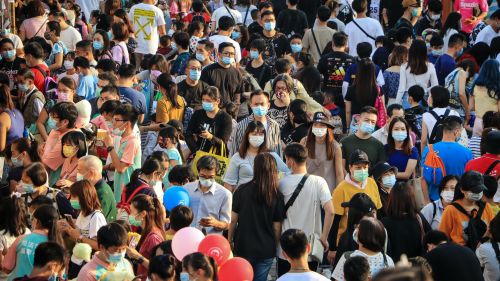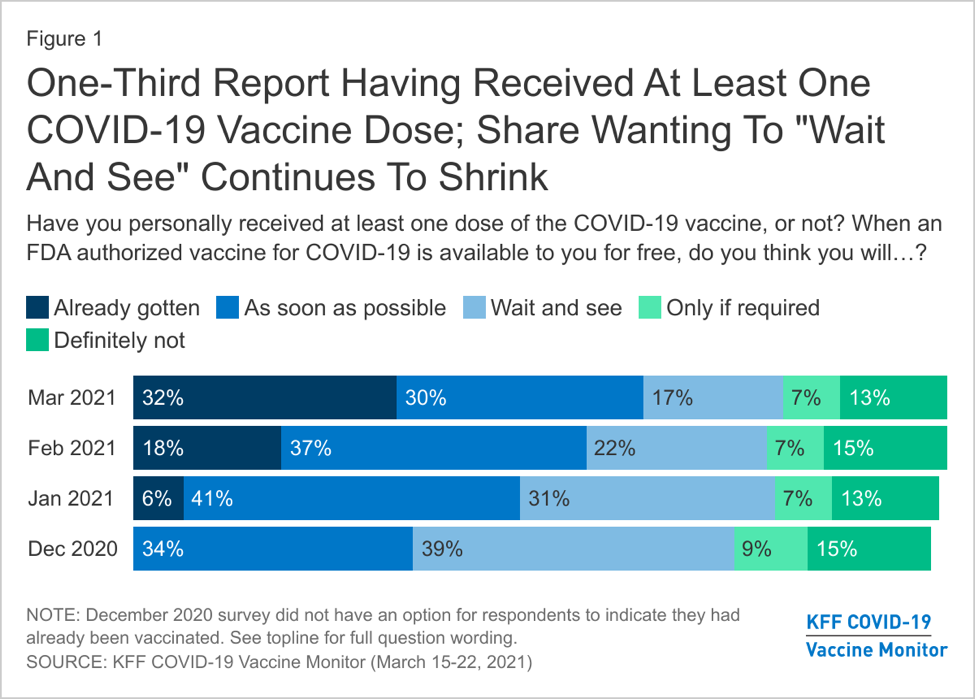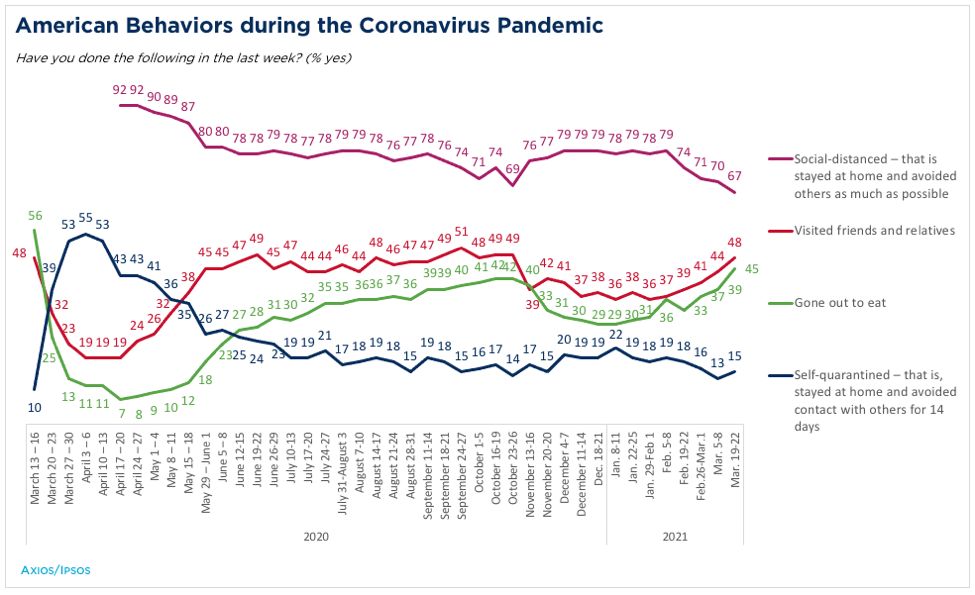As Vaccinations Increase, Global Public Opinion Shows Varied Sentiments

Outbreaks continue to emerge even as vaccinations increase; some countries feel safe to engage in more normal activities while others introduce new restrictions.
This week the world passed the 128.2 million case mark, with over 2.8 million deaths attributed to COVID-19. Although many countries still see plateaued or rising cases, vaccination efforts have led Americans and Britons to feel safer engaging in normal activities. Meanwhile, vaccine hesitancy continues to persist across the globe as governments ramp up distribution.
For this week’s COVID-19 update, the Chicago Council Survey team looks at polling results from the United States, Japan, South Korea, France, the United Kingdom, Mexico, and Indonesia.
Key Findings
- With a third of the adult population at least partially vaccinated, most Americans (76%) believe things will be back to normal within the next year and are increasingly engaging in normal activities.
- A large majority of Japanese (90%) are either very or somewhat concerned about a fourth wave and just over half (51%) express disapproval towards the government’s COVID response.
- Three-quarters (76%) of South Koreans report spending less time at dinners with colleagues during the course of the pandemic. But half (52%) report an increase in work-related stress.
- As cases begin to rise again in France, seven in ten people (70%) approve of the partial lockdown enacted to prevent another large wave.
- Two-thirds of Britons (67%) say the UK government should use the pandemic to overhaul social care in Britain, but opinions differ on its implementation.
- A third of Mexicans (32%) list COVID-19 as their biggest worry but also show a hesitancy to the vaccine, with just over half (52%) saying they are willing to get vaccinated.
- As Indonesia struggles to distribute vaccines to its 6,000 inhabited islands, an increasing majority (56%) believe the vaccine is safe for its users.
The United States
30.4 million cases, 550,500 deaths
At pharmacies and mass vaccination sites around the country, millions of Americans each day are getting vaccinated against COVID-19. With a third of the adult population at least partially vaccinated, most Americans (90%) know someone who’s been vaccinated, according to the most recent Axios/Ipsos poll. And according to the latest <Kaiser Family Foundation poll, fielded March 15-22, vaccination enthusiasm continues to rise. In December, only a third of Americans (34%) said they wanted to get a vaccine as soon as possible, while a narrow plurality (39%) said they’d wait and see. Now, nearly as many (32%) have already gotten at least one dose of the vaccine, and another three in ten (30%) say they want to get one as soon as possible. As the vaccine rollout has gone on, the percentage of the public who prefers to wait and see has steadily shrunk, down to 17 percent today.

African-Americans have seen the largest increase in vaccine enthusiasm, with half (55%) now saying they have either gotten vaccinated or want to get a vaccine as soon as possible, up from just two in ten (20%) in December. Desire for a vaccine has also grown notably among Hispanics, with six in ten (61%) saying they have already gotten vaccinated or want to get vaccinated as soon as possible, up from 26 percent in December.
As KFF polling shows, the main divide in vaccine intent is not racial, but partisan. Democrats (79%) are far more likely than Independents (57%) or Republicans (46%) to say that they either plan to get vaccinated as soon as possible, or already have been vaccinated.
Additionally, what both the KFF and Axios/Ipsos trends show is that as the vaccine rollout has gone on, many Americans who were on the fence about vaccination have decided that they’ve seen enough and want one as well. However, a subgroup of the population that is vaccine-skeptical remains unconvinced.
As more Americans get vaccinated, a return to normal, pre-coronavirus life seems close at hand. Most Americans (76%) believe things will be back to normal within the next year, and a quarter (25%) say they will be normal within three months. Normal life also seems less risky than before: in Axios/Ipsos polling, 59 percent of Americans see a return to normal as a large (23%) or moderate (36%) risk, the lowest since early June.
With normal life so close at hand, the proportion of Americans who are engaging in normal behaviors is rising steadily. In the past week, nearly half of Americans say they’ve visited friends and relatives (48%, up from 36 percent in early February), and a similar proportion say they’ve gone out to eat (45%, up 30%). At the same time, fewer Americans report social distancing: two-thirds (67%) say they’ve stayed home and avoided others as much as possible, down from 79 percent six weeks ago.

However, the pandemic isn’t over—rising cases and hospitalizations in several states across the country is raising alarms among public health officials. CDC director Rochelle Walensky recently warned of ‘impending doom’ and a potential fourth wave. It’s a race between the virus and the vaccine.
Japan
472, 112 cases, 9,113 deaths
Only weeks after the most recent state of emergency was lifted in Tokyo, Japan may be facing a fourth wave of COVID-19 infections. This time the center of the wave is in Osaka, where Governor Hirofumi Yoshimura has already requested additional support from the central government. A fourth wave will confirm public fears: an Asahi Shimbun poll conducted March 20-21 finds nine in ten Japanese either very (50%) or somewhat (40%) concerned about another wave.
It will also prove another challenge for Prime Minister Suga, whose approval rating remains mixed (40% approve, 39% disapprove), though this represents an improvement from February’s more negative results (34% approval, 43% disapproval). Evaluations of the overall COVID-19 response have remained more negative, with half giving the government negative marks (51%, down from 56% in February). And a similar proportion of the population says that the lifting of the state of emergency in Tokyo came too early (51%), while a third (32%) sees the timing as appropriate (and 11% say it came too late).
Getting a better review from the public is the vaccination campaign, which 69 percent of the public views very (7%) or somewhat (62%) favorably. And in Nikkei polling conducted March 26-28, speeding up the vaccination campaign is the public’s top priority in the fight against the coronavirus: 44 percent pick faster vaccinations, far above expanded testing (17%) or identifying novel virus variants (15%).
The public emphasis on faster vaccinations also reflects a growing public desire to get vaccinated. In Asahi polling, four in ten (39%) say they want to get vaccinated as soon as possible, up from three in ten (29%) last month. Another half of the public says they want to first wait and see (53%, down from 62% last month). However, the primary obstacle to Japan’s vaccination campaign remains a limited supply of vaccine. The country is still working through its first priority group of medical workers, and is waiting on additional shipments to arrive in May.
Once vaccinated, Japanese will not only get protection from COVID-19 – they’ll also get a vaccine passport. Japan is the latest country to develop a mobile app for displaying vaccine status and testing results, though there are no plans yet to re-open the country to foreign tourism—including for the upcoming Olympic and Paralympic Games.
South Korea
103,088 cases, 1,731 deaths
As of March 31, South Korea reported 506 new COVID-19 cases. These numbers have slowly increased over recent weeks but are in line with past numbers of recorded cases. Even so, the South Korean government extended coronavirus restrictions on March 26 for another two weeks.
The South Korean maintains its goal of reaching herd immunity by November, and the country recently began distributing vaccines to hospitals, nursing home employees, and citizens older than 65. The Korea Disease Control and Prevention Agency announced that 680,000 high risk and critically ill citizens were vaccinated as of the end of last February.
For the public, the coronavirus pandemic has had several noticeable affects. According to a Gallup Korea poll conducted March 4-12, the biggest change has come in terms of “staff dinners.” Dinners among colleagues are a regular feature of work life in South Korea, and these get togethers are notorious for their heavy drinking lasting into the late night. But with the coronavirus restrictions, and restaurants closing at 10pm,76 percent report spending less time at these dinners. However, a majority (52%) report an increase in work-related stress.
France
4.5 million cases, 95,337 deaths
Despite France’s efforts to stem the virus, cases are beginning to rise once again, and are nearing levels seen during the peak of their worst wave in November. As of Monday, intensive care beds were 90 percent full: the same as the peak of ICU occupancy on November 16. In order to prevent another large wave, the Élysée on March 20 introduced a partial lockdown for 16 regions, including Paris, Nice, and parts of Normandy. While schools will remain open in these areas, the rules indicating which businesses may remain open is still in effect, and many businesses are still closed. A curfew of 7pm is in effect for these regions.
Although an Odoxa survey fielded March 18-19 shows that seven in ten French people (70%) approve of this measure, those who are in the regions placed under lockdown are less likely to approve (56%; 43% opposed). Nonetheless, majorities of French people are approving toward the new measures, including the prohibition of inter-regional travel (74% approve) and the continued opening of schools (67%). Only a minority, however, approve of the continued closure of businesses deemed non-essential (42%), while 57 percent are opposed.
Though there is division over the measures enacted in France, nearly eight in ten say that these actions should have been taken sooner (78%). As this is the third lockdown in the past year, the French people are experiencing ‘lockdown fatigue’—potentially impacting their willingness to closely follow these new rules. Asked how closely they would follow these rules, 53 percent say they would follow them scrupulously; another 47 percent, however, will at the very least allow themselves to break the rules sometimes (37%), while another 8 percent say they will not respect them 2 percent say they will protest or express their discontent on social media. In general, younger people are significantly more likely than older people to have the intention to break the rules either somewhat or entirely (67% of those aged 18-24 vs. 25% of those aged 65 or older.
The United Kingdom
4.3 million cases, 126,670 deaths
The United Kingdom continues to see success in containing the virus as cases plateau around 4,000 per day and deaths have fallen into double digits per day. Nonetheless, deaths in the United Kingdom have surpassed the 150,000 mark, according to an analysis by The Guardian: the fifth highest death toll in the world. As such, there are aspects of Downing Street’s pandemic response with which Britons take issue.
A March 17 survey of British adults by Redfield and Wilton found that in particular, people take issue with the UK government’s handling of care homes. More people say that the government has done a bad job (42%) than a good job (33%) in protecting care homes from outbreaks, while another 22 percent say that they did neither a good nor a bad job. Given reports from the BBC that there were 30,000 excess deaths in care homes as of July 2020, it appears Britons have held these sentiments for nearly a year.
However, Britons are much more likely to say that the government did a good job in providing social care staff with essential protective equipment (48%; 19% bad job). At the same time, two-thirds (67%) of Britons say that the UK government should use the pandemic as an opportunity to overhaul social care in Britain. But what this overhaul looks like varies for Britons. Slightly more than four in 10 British people (42%) say that social care should remain free at the point of use like the NHS; this has fallen from 50 percent in July of 2020. Another third of Britons say that social care should be funded like a pension (33%) and 8 percent say social care should be paid for by individuals and families when they need it. This decreasing preference for universal social care may prove to be a significant change for Britain should public opinion continue to trend in that direction.
Meanwhile, Britons are feeling increasingly safe as cases and deaths decline across the United Kingdom, according to a March 22 Redfield and Wilton survey. Now, 52 percent of British people say they would feel safe going to a restaurant or pub which is outdoors, up from around 25 percent who said so in January 2021. By contrast, just 36 percent say they feel safe eating indoors at a restaurant or pub. More broadly, a majority of British people say that with respect to the timeline of the pandemic, the worst is behind them (56%), compared to just 22% that say the worst is yet to come.
Mexico
2.2 million cases, 202,633 deaths
Mexico’s COVID-19 death count surpassed 200,000 last week, making it the third highest in the world, after the United States and Brazil. However, according to a recent government report, the real death toll is likely 60 percent higher due to insufficient testing. At the moment, Mexico is recovering from its largest wave of infections, which peaked in January. As the number of infections decreases, there appears to be a shift in priorities among the Mexican public. According to a Mitofsky survey conducted March 19-21, crime emerged as the biggest fear, replacing COVID-19, which has occupied the top place since last December. Around three in ten (33%) now identify COVID-19 as their biggest worry, compared to four in ten for much of January.
Regarding attitudes toward the coronavirus itself, the Mitofsky survey shows a public that is fearful of contracting the virus, though also hesitant to get vaccinated. The vast majority (80%) of respondents are very or somewhat afraid that they or a family member will contract COVID-19, while nearly seven in ten (68%) fear dying as a result of infection. Meanwhile, fewer than half (46%) of respondents indicate that they will try to be one of the first to get vaccinated if vaccines become available. For the rest, roughly four in ten (44%) say they prefer to wait until after the first round of vaccinations, and 5 percent do not wish to get vaccinated. A GEA-ISA survey conducted March 6-9 shows that slightly over half (52%) say they are willing to get vaccinated; one in five (20%) say they are not sure, and around three in ten (28%) say they will not get vaccinated.
Mexicans’ hesitancy about receiving COVID-19 shots may further hamper the country’s vaccination campaign, which so far has only inoculated 0.6 percent of the population, according to figures from Johns Hopkins University. Mexico started vaccinating its population last year, but its plan has been disrupted by delays in supply. In January, half a million medical workers who had received one dose of the vaccine were forced to wait longer than the optimal three-week interval before receiving the second dose. Since Mexico’s rocky start with its vaccination campaign, supply has become more regular and the country has now secured enough doses to vaccinate its entire population. On March 24, President Andres Manuel Lopez Obrador promised to deploy more military, state, and local personnel to deliver vaccines in order to protect the population from a new wave of infections.
Indonesia
1.5 million cases, 40,858 deaths
Since the beginning of 2021, Indonesia has grappled with one of the worst coronavirus outbreaks in Asia with just over 1.5 million cases and 40,000 deaths. In recent weeks, however, new daily cases have declined significantly, and vaccination efforts have begun, leading many to express optimism about the county’s future. According to a March 15 YouGov poll, a majority of Indonesians (56%) think the coronavirus situation in their country is getting better, an eight percentage point increase since the last report on March 1.
Indonesia, however, still faces many challenges associated with the pandemic. Most notable is how to effectively distribute and administer vaccines to its over 6,000 inhabited islands. At its current rate of 400,000 vaccinations a day, it would take Indonesia 10 years to reach its goal to protect 180 million of its 270 million people. After recently abandoning its strategy to vaccinate its young population first, the Indonesian government has now proposed a new plan to expand distribution through corporate measures. Designed to run parallel to the general vaccination effort, private companies will now be able to buy doses themselves and distribute them to their employees and families for free. Proponents of the move believe corporations will help productivity and ease the burden on the government; opponents, on the other hand, say it promotes inequality and gives special treatment to the wealthy.
Another challenge facing Indonesia is convincing its citizens to take the vaccine. According to a national survey in December 2020 conducted by Saiful Mujani Research and Consulting (SMRC), a majority of Indonesians (56%) believe the government provided vaccine is safe for its users. A minority (23%) distrust the vaccine and cite concerns over effectiveness and whether it is “halal,” or permissible. Because a large majority of Indonesians (87%) identify as Muslim, questions over the vaccine’s compatibility with Islamic customs has been raised. During a recent announcement from Indonesia’s Food and Drug Authority, an official from the country’s highest Islamic body declared the controversial AstraZeneca vaccine “haram,” meaning forbidden, for containing a pig derivative, but still approved its use by Muslims because of the unprecedented pandemic conditions. Another vaccine in question, the Chinese CoronaVac, was deemed halal and has since been distributed as part of the country’s vaccination program.





